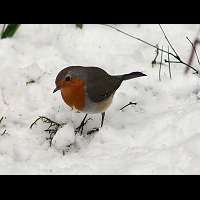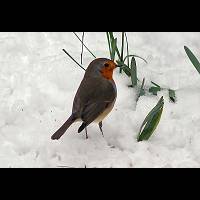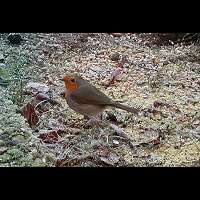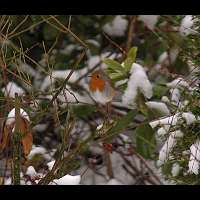Robin
All pictures on this page are thumbnails. Click on a thumbnail for an enlargement of usually some 800x600 pixels. The enlarged photos vary from 50 to 150KB in size.
6 sec / 22 kb
Robins are beautiful, nosy and cheeky birds
The Robin is a very common garden bird, but still you don't see lots of them. That's because this curious and funny bird is also a rather agressive one. It's territory is large and other Robins are not allowed in. Still there are more then 1 million of them in Holland. This means that it is the number five of most common birds in Holland, just behind the Chaffinch. Males and females are only together for about four months of the year. After that they split up and both make an a new territory, just for themselves. Although the birds are not shy at all and even curieus, they are not as tame in Holland as they are in England. Young chicks are not at all as charming as the adults. The one on the main bird's page, photographed when sitting in our backyard with his parents sitting nearby and keeping an eye on the photographers activities, is a striking example. When you see one, during this stage they can fly just a little, you might think that it has been abandoned by it's parents, but don't be mistaken, they are probably close by! So don't feel pity for things like this and don't pick them up.
In winter the Robin quickly takes advantage of our feeding table, even though you see one individual only.
![]()
This bird belongs to the family of Thrushes (Turdinae). It is very common in our garden and can be seen in Holland all year round. The bird is 5,5" and weighs 16 grams. It lives in woodlands, gardens and parks mostly. It eats insects and spiders. The sexes do not differ from one another. Both males and females occupy their own territory, in which no other Robin is allowed. Only somewhere between May and July a male and a female Robin might share a territory. Then four to six eggs are laid in a nest that is build on the ground or near the ground in bushes. It takes the eggs 14 days to hatch. The young remain in the nest for another period of 14 days.
![]()
| Name of this bird in various other languages | ||||
| Dutch | German | French | Polish | Scientific |
| Roodborst | Rotkehlchen | Rouge-gorge familier | Rudzik wlasciwy | Erithacus rubecula |






